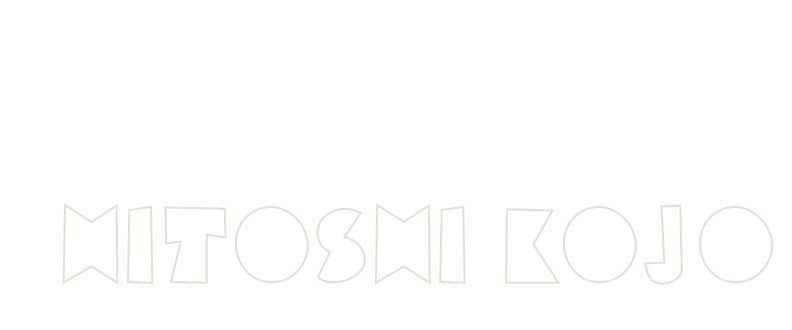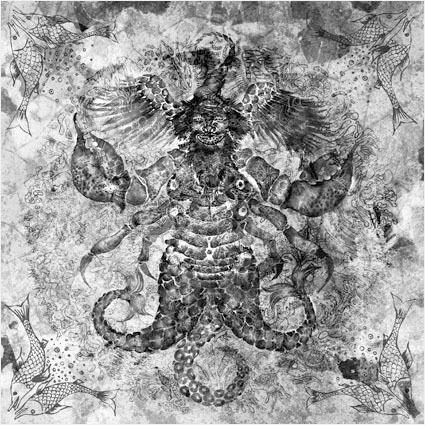Review
The limited 10-inch Ezo allows the versatile Hitoshi Kojo to enchant the listener with vague notions of animism and potential energy. As opposed to his fascinating Kodama project — a partnership with Michael Northam that was typified by bursting, electronic builds, repetition, and long-form structure that demanded the listener to grasp for context and meaning — Ezo, due to both its short length and its powerful, immediate initial burst, immediately immerses the listener in a largely natural, fast-paced world. It would serve as a natural contrast, in fact, to place Ezo’s familiar sounds of sloshing water and scraping metal, at all points filling the sound spectrum, with the alternately full and empty electronic drones and close-listening activities that menace and stare throughout Kodoma’s Turning Leaf Migrations.
To understand Ezo, and to get a sense for why it is an exciting record, it is important to see its place in Kojo’s 2009 output. Ezo serves as a bridge between the highly successful Kodama and the unsuccessful drone/ambient project Libellula, a trio comprised of Kojo, Sebastian Clinger, and the aforementioned Northam. (2) saw Libellula become too subdued, too reliant on nuance, and because both the nuance lacked detail and the structure lacked sufficient differentiation from a standard genre piece, the result was forgettable. Kodama solved all these problems, but the results were only tangentially related to drone. Instead of relying on new streams to add color to a drone, Turning Leaf Migrations varied the density, displayed a masterful grasp of movement within the stereo spectrum, and utilized a host of different sound sources, be they electronics, found sounds (such as water, insects, and walking), or whatever was on hand.
While Ezo predates the release of both of these records, it was constructed well after them. Kojo, cryptically explaining his thought process, speaks of the sound sources heard on the album, the resonances of everyday objects, and the spaces that contain those objects. Tellingly, he also makes reference to the artifact, the very record in discussion here. Each pressed record is its own object, with its own resonance, to be used and slowly degraded like anything else. Perhaps to Kojo, all physical objects have powerful potential resonances, and the environment within which they are found is the key to bringing forth such sounds. With this approach, Ezo differentiates itself from (2) in that it properly illustrates, rather than alludes to, the sound within things. Likewise, Turning Leaf Migrations is distinguished from Ezo by its exponentially greater direct manipulation of sounds. In other words, Kojo is letting things speak for themselves.
That said, Kojo’s artistic task, as with most musicians utilizing found sounds, is to get these things to say something, to mean something. The chosen approach is normally juxtaposition and/or layering, and Ezo is no exception. The introductory sound of pouring water quickly turns from serene to tumultuous, subtly morphing into a swirling sound, ice cubes seemingly flush to the edge of a cup, pressed harder and harder as scraping metal and low-register vibrations form an abrasive focal point. High-pitched activity towards the top of the composition gives way to a multiplication of the initial water motion, just as the metallic scraping and rumbling become increasingly unhinged.
Without spoiling the record’s moment-by-moment development, what does it mean? Ezo is an interpretation not only of Kojo’s surroundings, but also of Kojo himself. After all, if the object can beget the sound, and the sound can beget a new object, isn’t the architect also a layer and also an artifact? It stands to reason, then, that Kojo has his own resonance, and to unlock it, to decipher his meaning, you must place him in some context — namely, this record. Coupled with notions of impermanence; the destructive, unstoppable force of water that is ever-present on this record; and the building, manic metallic noises, Kojo could be exploring notions of his own degradation — a sense of invisible but surely present decay of his self and the emotions those realizations foster: fear, anger, aggression, helplessness. Ezo therefore represents a development for Kojo, a progression from passive, to active, to aware.
In short, Ezo is the crucial link that turns three albums into a telling, personal character arc, where both the works and the artist are revealed as fragile, organic things. Ezo is the sound of an artist becoming self-aware and deciding to sculpt awareness from whatever happens to be within arm’s reach.
Killed in Cars Blogspot
Occasionally working in the past as Spiracle, Hitoshi Kojo presents this thoroughly amazing piece of ancient-sounding drone music.
No doubt, Kojo's work will be compared to that of the classic Organum sound; but considering that very few have even come close to replicating the power and mystery of such classic Organum recordings as Ikon or Horii, such parallels should be taken as the highest praise.
Kojo claims that all of the sounds originated from various found objects. He doesn't specify beyond that, but all of the objects must be metal in origin, probably large pieces of sheet metal, or flexible rods of steel, or long pieces of wire, or something equally resonant and with a dynamic timbral quality. Each of these objects is bowed in order to coax a controlled dissonance of metallic screeches, protracted tonal bellows, and various acoustic drones.
The two compositions are simple in their moderate pacing of the ebb and flow between all of these sounds, not too slow... but certainly not too fast. Through these recordings, Kojo offers very little in the way of digital treatments or effects of any nature. Just a terse edit of one layer here, or a reversing of a metallic gong decay there. The results are a timeless set of interlocking metallic rasps and gasping drones that rivals what Harry Bertoia, Taj Mahal Travellers, LaMonte Young, and of course Organum had done so impeccably in the past. Beautiful, mysterious, and very highly recommended!
Aquarius Recordings (Jim Haynes)
A few weeks ago I reviewed a record by Kodama, the collaboration between Micheal Northam and Hitoshi Kojo. The latter we know also as Spiracle, his solo outing which we reviewed before when discussing releases on Taalem and Mystery Sea. I have no idea when Spiracle is in place and when his own name applies. Especially his Taalem release seem to come close to 'Ezo'.
In both he uses metal sheets or metal strings to play music that is not unlike the very early Organum 'In Extremis' sound, but whereas Organum slowed down his tapes to get his full sound, Kojo doesn't slow this tapes, but opts for a multi-layered sound. He staples as it were his material together. All sorts of possibilities to play the metal with bows are used here, but the beauty lies in the mix of the multiple sound sources.
Two lovely pieces here pressed on vinyl, which have exactly the right length to maintain full interest by the listener. A fine little record, a great, daring piece of drone music, and one that is created almost acoustically. That's how these thing should be done. More I'd add.
Vital Weekly 666 (Frans de Waard)
|



